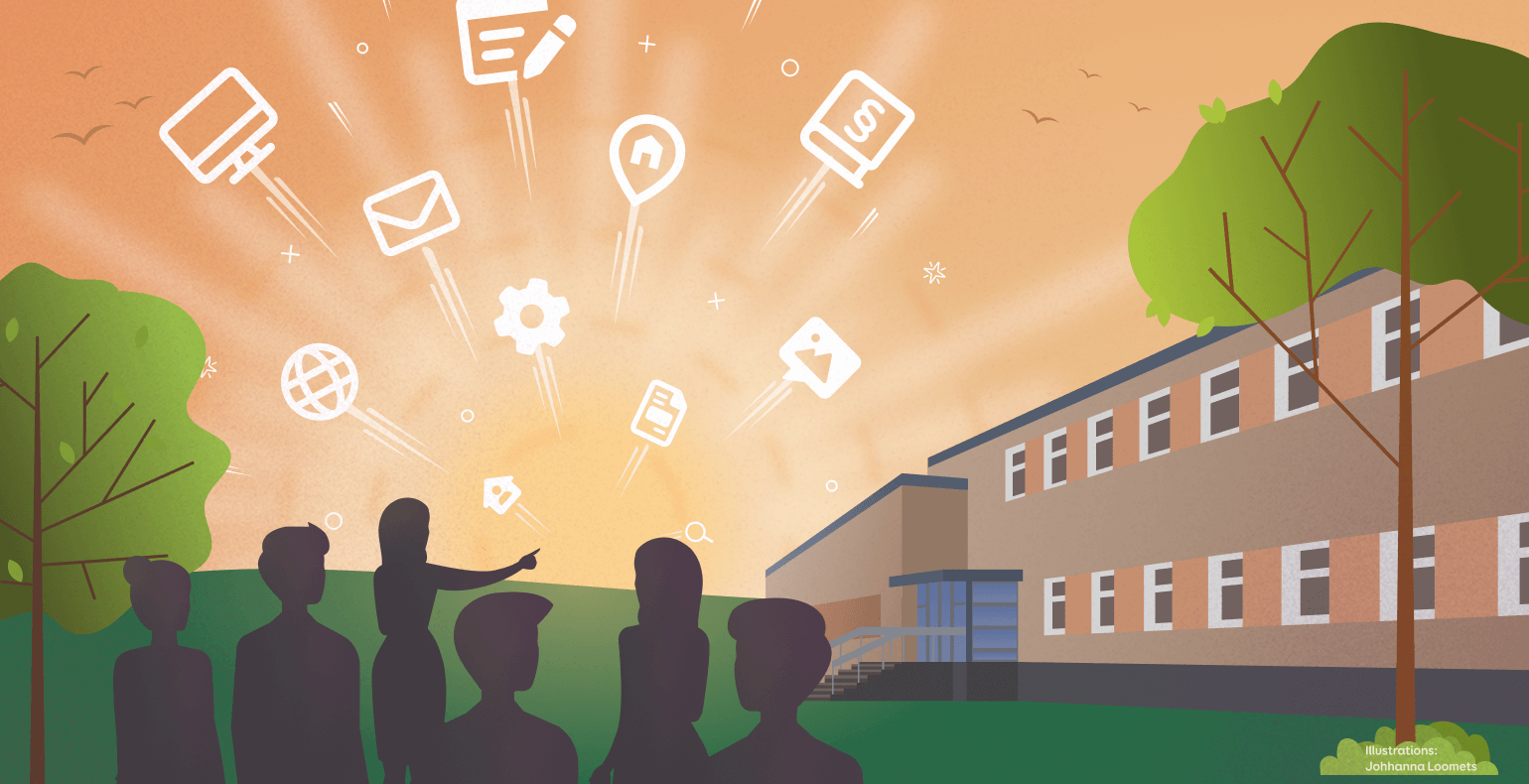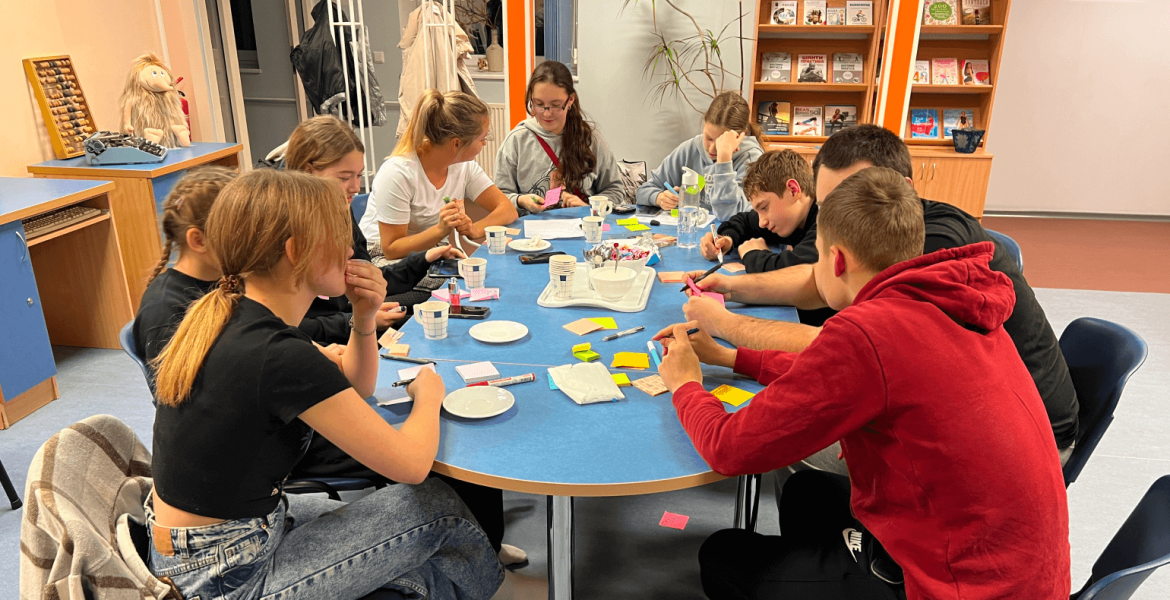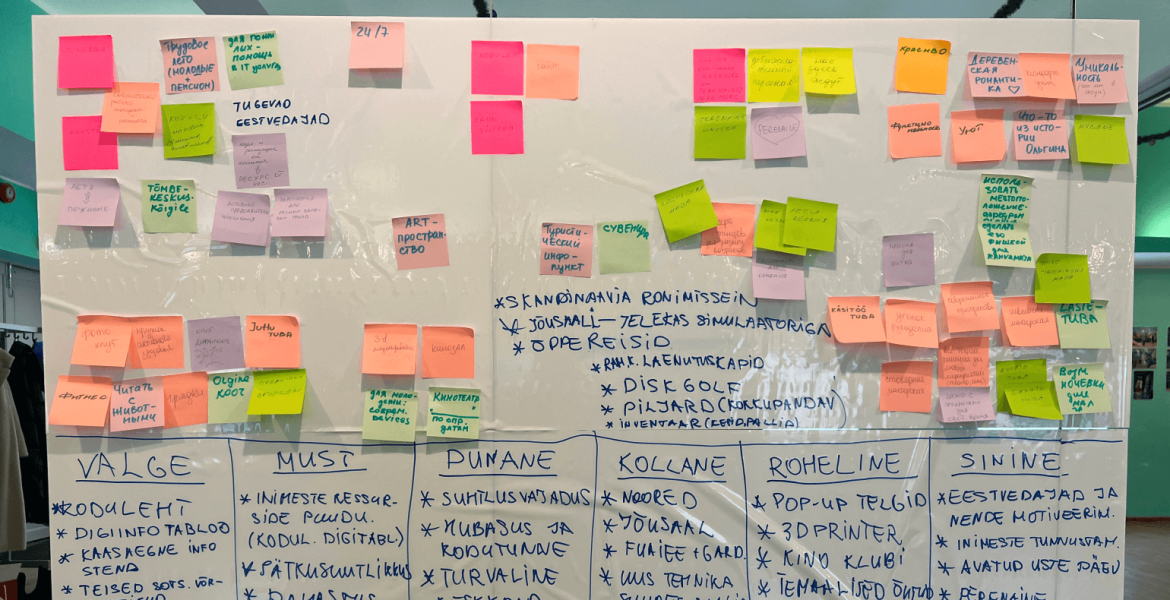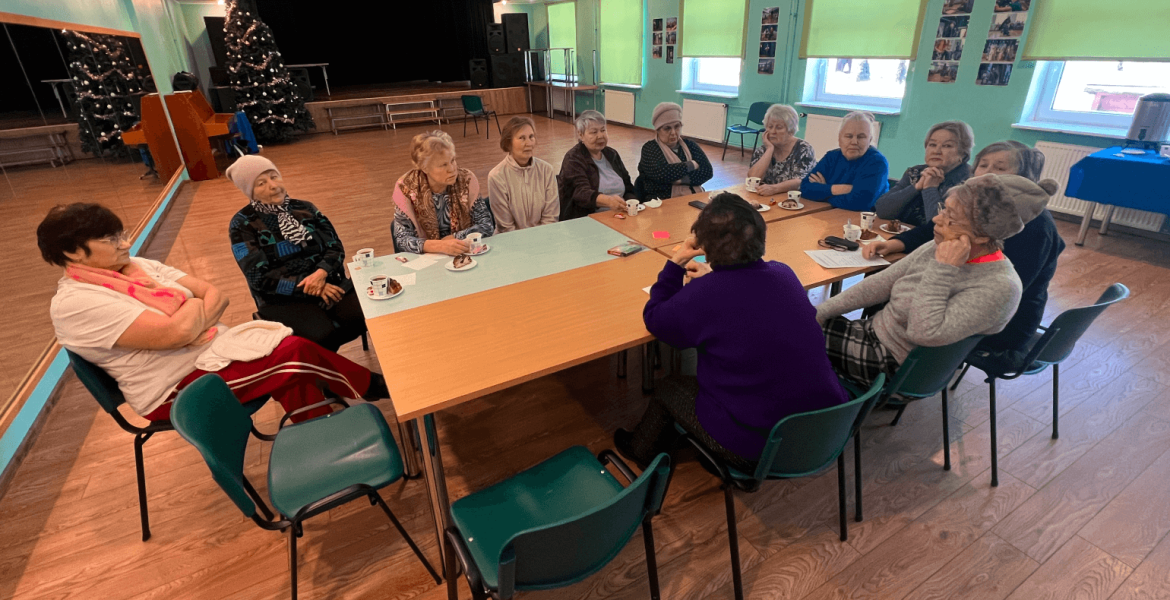Mapping customer needs to support the development of a new concept and the renovation of the Olgina Community House
Close your eyes and imagine a nostalgic space that is meaningful just for you. Is it your first school, where you know every corner and how the morning light fell diagonally on the classroom wall? Or a trail in the City park that leads to the University in the end of the Spring semester, lilac bushes in bloom?
Or is it a week at that sports summer camp – wooden house and bunk beds and a life full of adventures, new friends and barefoot freedom? Whatever is this space, it is cherished in your heart and stored there forever, and most likely has positively affected your life. It has left a trace.
Common spaces such as the cultural centers, parks, and public squares of our childhood are the heartbeat of the communities - the places where connections to others are strengthened. These spaces shaped our youth, contributing positively to our growth, creativity, and social bonds.
But as cities evolve, so too must these communal spaces as it is crucial to ensure that they continue to meet the changing needs of their inhabitants. The Olgina rahvamaja cultural center in small town of Olgina in Ida-Virumaa is one such space, built in 1976 and cherished not only by generations of Olgina citizens but as well Narva and Narva Jõesuu inhabitants.
Legendary Ivan Burov led and trained in Olgina Rahvamaja the local boxing club "Vaivara Võit" from 1999 to 2014, making a significant contribution to the development of boxing and the athletic education of youth in Narva-Jõesuu.
A rapid chess tournament in memory of Paul Keres is also held at the Olgina Community Center annually, supporting the culture of chess in Ida-Virumaa. Olgina was also a residence and training site of Estonian Winter Olympic skier Vello Kaaristo.
Nowadays Olgina Rahvamaja is a place of everyday education, as it offers a variety of language courses, craft and cooking activities, dance and singing classes. Youth club and Retirees club are gathering every week for socializing, planning activities and sharing the local news.
It has a festive mirror-room which has been a place of celebrations, local fairs and community get-togethers. There is an actively used library and computer corner on the second floor. Olgina rahvamaja has also an impressive sports hall that has been a training base for basketball, volleyball, aerobics, and group workouts.
But being now almost 50 years old the building needs a substantial reconstruction to remain relevant and accessible for locals.
Researching for improved service design while respecting vulnerable customers’ needs
In the recent years there has been a lot of focus on accessibility and inclusivity, with WCAG guidelines being continuously updated and several accessibility acts (ADA, European Accessibility Act 2025) implemented. Read on our website about how accessibility creates equal opportunities. Our specialists can assist you with digital accessibility audits, as well as consultations or training.
However, there is another layer of customers who can benefit from additional attention and care during service design processes – vulnerable customers. European parliament in their briefing on Vulnerable customers issued in 2021 gives a description “Compared to the average consumer, who is 'reasonably well-informed and reasonably observant and circumspect', some consumers require additional protection because they are particularly vulnerable due to their mental or physical infirmity, age (children and elderly people) or credulity.“
It is also worth to mention that customer vulnerability can change over the course of time (e.g. age-related) and circumstances (pregnancy and maternity leave affect both women’s physical performance as well as financial stability). Originally coming from finance and city planning domains the concept gradually gets adapted by the service designers more and more. This project was one of the first ones where Trinidad Wiseman tried to apply theory of working with vulnerable customers to practice.
While Narva-Jõesuu KOV aims to renovate the center to make it more sustainable, it also seeks to modernize the services offered by incorporating digital tools.
However, while Olgina Rahvamaja modernization and digitalization promises efficiency and convenience, it also risks alienating vulnerable groups, particularly retirees, children and youth. Taking this into accunt it was crucial to carefully research the needs of Olgina rahvamaja visitors so the renovations and design of the services could be built around their requests, physical needs and various time limitations.
The challenge of gaining trust in a close-knit community
In small communities a stranger is welcomed with caution, especially if their aim to learn about sensitive topics of local lifestyle, everyday challenges and aspirations. So, gaining trust among locals and treating their feedback with patience and respect was one of the top priorities on Trinidad Wiseman specialists.
It was equally important to hear as many proposals and opinions from locals as possible but also to conduct in-depth research about motivations for visiting the Olgina community house in future. As there were more than 60 candidates who agreed to participate in the study, it was decided to host 5 workshops (each lasting approximately 2-3 hours) and 6 one-on-one interviews (each 1h).
The workshops included mapping participants needs for education and recreation with a goal to increase their attendance of the Olgina rahvamaja. In the interviews we tried to look deeper into motivations behind selections of activities, overall lifestyle of Olgina habitants and alternative ways to use the house grounds.
The working groups for the workshops included: seniors and retirees (60+ age group), schoolkids from the local Youth club, working adults or Olgina, Narva-Jõesuu KOV workers and Olgina community centre employees and service providers.
In the workshops, we used several co-design techniques and approaches:
- Creating an affinity diagram, where workshop participants wrote down their ideas individually (one idea per sticky note), and then the moderators collected and grouped these ideas into clusters or themes on the wall. This method enabled idea generation without the influence of groupthink or others’ opinions. It was particularly important for both young people and seniors, as they tend to be more susceptible to peer pressure.
- For those who had difficulty generating ideas, we used the “This, but not that” approach combined with inspiration cards. Both seniors and young people often have a non-conformist attitude and are usually very clear about what they don’t like (or even hate) about the current situation. This technique provided a good way to shift from a negative perspective to a positive future vision.
- For larger stand-alone problems, we also used Edward de Bono’s famous “6 Thinking Hats” technique, which allows examining the same problem from different perspectives by wearing metaphorical hats: analytical, positive, creative, pessimistic, etc. This helped participants view the problem from multiple angles and understand both the constraints and opportunities.
Several steps were taken to gain the trust of the locals:
- Workshop and interview participants were recruited via KOV representatives who were familiar to them and hence could pose as a trusted ambassador of the project. We attribute high participation rate to this strategy, which might not be a regular approach in the industry, but it has worked in this case.
- We explained potential benefits of the research but were also honest about project’s limitations (that not all proposed ideas will make it into the final list).
- We conducted interviews in Russian, a local minority language that most of the Olgina habitants speak.
- Trinidad Wiseman team maintained maximum transparency about project goal, research methodologies, possible outcomes and how the data will be saved, anonymised, processed (storage of the recordings and transcriptions) and used in the final report.
- We brought tea and cake to each workshop and interview.
As the result of our efforts, people did open! All the questions were answered, proposals validated, and all opinions and experiences were heard with an equal interest (even the stories of neighbour kids stealing the biggest pumpkin from the patch last year).
It was also important for us to learn from the experiences of other service providers in the Ida-Virumaa region. To achieve this, we visited Narva and spoke with employees and representatives of the Narva Library, Narva College, and Olgina Airfield.
We explored their experiences with renovations and promoting services among the local community. Additionally, we inquired about logistics and work processes, considering the specific characteristics of the region (such as Russian being the main language among locals, an aging population, at-risk youth, etc.).
When locals become the service designers for their own product
Once all the interviews were done and workshops conducted the TWN gathered Narva-Jõesuu KOV representatives for one final workshop to go through the initial findings. We discovered a peculiar problem – there was too much of the good and feasible ideas!
Obviously, it could be solved by sorting and prioritising, but it was still a shame to discard those that were out of this project scope. Afterall, they were nicely formulated, applicable to other projects or even on a volunteer basis and were clearly dear to locals. Trinidad Wiseman and the client has mutually agreed to keep all the ideas in the report, but keep those out-of-scope ones as a separate Annex.
The study results show that for all age groups, it is important that the community house is open throughout the week. A cosy atmosphere and diverse options for spending free time, especially during cold weather, are essential. One of the most frequent requests was for a training gym.
Interestingly, both young people and pensioners expressed an interest in handicrafts, which may open opportunities for intergenerational cooperation. Of course, young people also want access to modern computers and equipment, such as 3D printers and drones.
The idea of a drone-flying club is supported by local experts. The Olgina airfield has the potential to receive international flights, which could prove important for the development of industrial areas in Ida-Virumaa. In the future, as the Olgina airfield and tech park grow and develop, the skill of operating drones and having a flight license may become a full-fledged profession.
Residents emphasized the need to organize activities for children aged 3–7, especially on weekends. These could include family sports events or craft and cooking clubs.
After getting to know residents through interviews and working groups, a new side of the people of Ida-Virumaa emerged. Interesting and talented individuals live and work here, ready to actively participate in the development of the region.
The active participation and openness of the Olgina community, as well as the local government, have been inspiring, creating a good foundation for further cooperation. Representatives from Trinidad Wiseman OÜ are grateful to all participants for their contributions.
As a result of the collaboration between Trinidad Wiseman and the Olgina community, the community centre is getting a new lease of life
In Summer 2024 Narva-Jõesuu KOV got long-awaited news that The Olgina Community House project has received the funding! On July 8, the State Support Services Center decided to approve the Narva-Jõesuu City Government’s project application for "Reconstruction and Development of the Olgina Community House into a Community Center."
The building will be reconstructed to be energy-efficient, improving space conditions and accessibility. In addition to the investments, services will be enhanced, and new information systems will be created. For example, a youth center and a gym will be established, an elevator will be built for access to the second floor, furnishings will be updated, a website with a booking system will be created, a drone club and a sewing club will be established, a 3D printer will be acquired, staff training will be conducted, a new management model will be developed to improve service delivery, a remote work station will be set up, and a logo and brand for the community house will be developed.
All the devices and new services mentioned above are based on findings from the research, which is why we can be confident that they will be utilized and hold real value for the lovely Olgina community. If you also have a community center that is important to you and could benefit from being reimagined through service design, feel free to reach out to our Head of Service Design, Liina. Together, we will find the right solution for your community!










